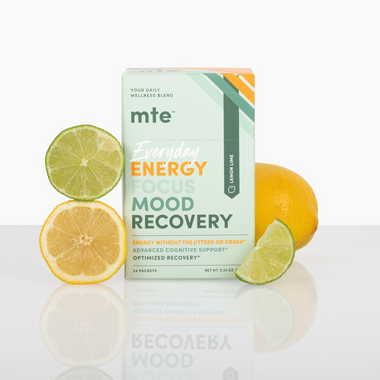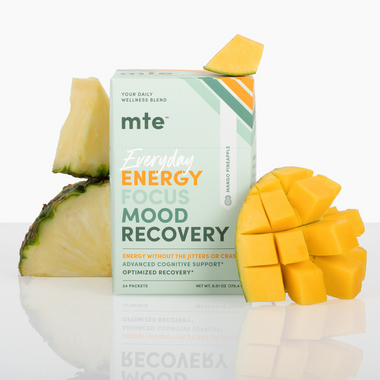
Fermentation Nation: Is Kombucha the Key to Better Health?
Your gut’s microbiome is unquestionably vital to your daily wellness as well as health and longevity. Did you know your digestive system actually has its own nervous system that operates separately from the brain? Some refer to the gut as a “second brain”, because it drives countless processes throughout the body that affect everything from daily energy levels to immune system integrity.
Beef tallow, apple cider vinegar, castor oil – there’s no shortage of influencers touting this or that as a way to unlock optimal digestive health and subsequently overall vitality. But often we find that there’s little to no science behind these claims – especially the beef tallow thing – chill out.
One of the latest TikTok wellness fads is fermented foods and drinks. Think tempeh, kimchi, yogurt, or kombucha. The big claims are that fermented foods increase bacterial diversity in your gut while also increasing resistance to pathogens. Is there anything behind it, though? Let’s find out:
The History & Function of Fermentation
It’s likely that people in North Africa began fermenting foods around the Neolithic Revolution (10000-12000 years ago). The first may have been yogurts and cheeses, which were thought to be processed in goat and sheep bags filled with milk. A couple thousand years later, we see fermented fruits, rice and honey appear in East Asia. Another couple thousand years later, we have beer in Egypt, and later, wine in Greece in Rome… the history of fermentation includes lots of alcohol.
Fast forward to the 17th century, when Louis Pasteur figured out exactly what was happening during the process of fermentation. A very, very tiny little animal called yeast was responsible. In an anaerobic environment (meaning little-to-no oxygen), this functional microorganism enhances nutrient availability and creates prebiotic and probiotics.
The result is a soured (due to acetic acid) concoction full of nutrients and gut-healthy bacterias. The fermentation process makes it so they’re protected until they reach the gut, which is why fermented foods are referred to as “functional” – they’re full of microscopic creatures that perform actions on your gut microbiome upon reaching the digestive system.
It wasn’t until the early 20th century that someone figured out the nutritional benefits of fermented foods, though. Until this time, fermentation had been used to extend the lifespan of foods that spoil quickly, and also to get drunk. But a study on Bulgarian lifespans vs fermented milk consumption led to the discovery of certain bacteria that benefited gut health.
The implication that people who consume fermented foods might live longer than others led to a 1920’s fermented milk fad (… ew). In the 1960’s, probiotics were officially defined as substances secreted by microorganisms that encourage the growth of other microorganisms. Good word of mouth and a heap of subsequent research eventually led us to the probiotic supplements and fermentation obsession we have today, almost exactly a century later.
Cultures Across the World Love Fermented Foods
Like most things, we see fermented foods across the globe. Some familiar to us, others not. Here are a few interesting fermented foods you may not have heard of:
- Central Asia: Chal is a fermented camel milk beverage made by adding fresh milk to soured milk over the course of several days. It is believed to have curative properties and is known for its very distinct, unpleasant odor.
- Greenland: Kiviak is essentially liquefied fermented bird guts. No joke — you gather around 400–500 dead birds, stuff them into a dead seal, and leave them to ferment for up to 18 months. Then, you cut the head off a bird and drink the fermented contents.
- Iceland: Hákarl is a fermented and cured shark meat dish made by burying a shark for 12 weeks, then hanging it in the open air for several more months. It is known for its strong smell and a taste of fishy ammonia.
North Atlantic friends… are you okay?
- Russia: Kefir is a fast-fermented milk beverage made by adding kefir grains to milk. It’s said that elite families hoarded and passed down kefir grains for centuries, until Russian physicians obtained enough to begin large-scale production.
- Southeast Asia: Su fu is bean curd fermented with mold and bacteria, then cured in a brine—usually made of rice wine, salt, and miso paste. It’s often compared to a soft cheese, though its taste and smell can vary based on the brine ingredients.
Historically, fermentation was mostly used for food preservation, flavor, and nutrient enhancement. Some cultures touted health benefits, believing some fermented drinks worked as immunity tonics. But now that we know the MVPs of fermentation – bacterial strains and probiotics – we can look at why they may offer functional benefits.
Where’s the Evidence Kimchi is Keeping Your Gut on Track?
So, is there scientific evidence behind the experiential observations? Yes! A review of the literature on the history of and scientific support for fermented foods synthesized results from dozens of studies:
a) Results from dietary studies indicate a strong correlation between weight management and the consumption of fermented milk drinks. These beverages are also associated with a reduced risk of heart disease, type 2 diabetes, and overall mortality. Additionally, they contribute to better glucose metabolism and faster recovery from physical exertion.
b) Observational studies on the milk fermentation process show that fermentation enhances nutrient availability and transport, and improves the digestion of complex carbohydrates. Moreover, the breakdown of proteins and lipids during fermentation produces bioactive compounds that are strongly linked to lower blood pressure, reduced cholesterol levels, and improved metabolic function.
c) Research on the byproducts of fermentation reveals that the process generates essential nutrients and functional compounds, including vitamins A, B7, B11, B12, and C, as well as polyphenols, antioxidants, free-radical scavengers, and bioactive peptides. Fecal studies confirm that fermented foods increase gut microbiome diversity.
d) Studies on specific fermented foods confirm their positive health effects. For example, kombucha has demonstrated protective effects against cancer and neurodegenerative diseases. Kimchi has shown potential in preventing arterial plaque buildup, while fermented milk has been found to reduce blood pressure across all age groups.
The Conclusion: There’s Truth to the Fermented Foods Fad
Like everything on TikTok, the grain-of-salt theory applies. However, it seems this social media fad is simply a combination of hijacked medicinal wisdom and modern science. Maybe it’s a good idea to add a kombucha or kefir to your morning routine. We’ll pass on that nasty fish thing, though… Sorry, Greenland. ☹
Curious yet? Some easy-to-find/make fermented foods and drinks include:
- Aged cheeses
- Apple cider vinegar
- Kefir
- Kimchi
- Kombucha
- Miso
- Sauerkraut
- Sourdough
- Tempeh
- Yogurt
But hey – not all of us love purposefully-let-it-go-bad foods. Whether it’s the concept of curdled cottage cheese or the sour taste of jarred cabbage, it’s no big deal – there are other healthy ways to support gut health and holistic energy.
MTE contains chicory root, a fibrous little plant filled with inulin, which has been shown to support digestive health and immune function. Along with 10 other key adaptogens, nootropics and superfoods, MTE is an alternative not just to energy drinks, but also to your cabinet full of wellness powders and pills.
Get a simple, pared-down daily companion you can actually feel working and ditch all that excessive caffeine and handfuls of supplements. Explore more about the science behind MTE on our Wellness Blog, Ingredients, and Benefits pages, and head to the Shop to get your first month’s supply!






